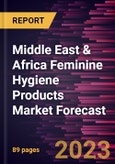Rising Adoption of Reusable and Eco-friendly Products Fuels Middle East & Africa Feminine Hygiene Products Market
Eco-friendly and reusable feminine hygiene products are becoming popular with rising sustainability concerns among consumers across the region. The non-biodegradability of female hygiene products is a major environmental concern. Thus, environmentally friendly sanitary napkins, panty liners, and tampons, among other feminine hygiene products made of natural fibers, are a viable choice. Organic cotton, jute, banana fiber, and bamboo are among the natural absorbent fibers. They are widely available and biodegradable, with a minimal carbon footprint. Using these fibers also lowers the production costs of feminine hygiene products. The absorbency and retention properties of these natural fibers make them a preferred choice over conventional options. Banana fiber, bamboo fiber, jute fiber, and a combination of cellulose-based hydrogel have a similar absorbency rate as compared to synthetic superabsorbent polymer (SAP). Similarly, in place of non-biodegradable polyethylene and polyurethane, a bio-based plastic made from starch can be utilized as a barrier sheet. A few companies that create eco-friendly products include Shethinx, Saaltco, and Wearedame. For instance, Boots sells plant-based applicator tampons that are both affordable and eco-friendly. Moreover, companies are adopting novel technologies, and launching reusable panty liners and sanitary pads, which are impermeable, chlorine-free, and reusable/washable. The launch addressed the increasing plastic population and Middle East & Africa warming caused by non-disposable tampons. Thus, the increasing adoption of reusable and eco-friendly feminine hygiene products is expected to create a new trend in the market during the forecast period.Middle East & Africa Feminine Hygiene Products Market Overview
The Middle East & Africa feminine hygiene products market is segmented into South Africa, Saudi Arabia, the UAE, and the Rest of Middle East & Africa. Increasing government emphasis on feminine healthcare, improving quality of lifestyle, and growing awareness regarding feminine hygiene are the key driving factors of the feminine hygiene products market in the region. In February 2018, Water Supply and Sanitation Collaborative Council (WSSCC), in collaboration with UN Women, implemented a joint program named Gender, Hygiene, and Sanitation in three countries in West Africa - Senegal, Niger, and Cameroon. The program was aimed at health, hygiene, and sanitation policies for women in these countries and promoting menstrual hygiene management (MHM). Also, women welfare organizations such as AFRIpads, Qrate, ZanaAfrica, Pad-Up Africa, Sanitary Aid Initiative, and Speak Up Africa are taking initiatives to offer sanitary aids and education about menstrual hygiene in rural and urban areas. AFRIpads, founded in a rural village in Uganda in 2010, manufactures reusable sanitary pads and partners with organizations such as UNICEF and Save the Children to improve African menstrual health. Also, they are creating and distributing “Girl Talk,” a comic booklet that explains menstrual periods in an engaging and accessible manner. Such initiatives by governments and organizations have contributed to the feminine hygiene products market growth in the region.Middle East & Africa Feminine Hygiene Products Market Revenue and Forecast to 2030 (US$ Million)
Middle East & Africa Feminine Hygiene Products Market Segmentation
The Middle East & Africa feminine hygiene products market is segmented into product type, distribution channel, and country.Based on product type, the Middle East & Africa feminine hygiene products market is segmented into menstrual care products, cleaning and deodorizing products, and feminine hygiene underwear. The menstrual care products segment registered the largest Middle East & Africa feminine hygiene products market share in 2022.
Based on distribution channel, the Middle East & Africa feminine hygiene products market is segmented into supermarkets and hypermarkets, drug stores and pharmacies, health and beauty stores, online retail, and others. The others segment held the largest market share in 2022.
Based on country, the Middle East & Africa feminine hygiene products market has been categorized into South Africa, Saudi Arabia, the UAE, and the Rest of Middle East & Africa. The Rest of Middle East & Africa dominated Middle East & Africa feminine hygiene products market in 2022.
Edgewell Personal Care Co, Essity AB, Kimberly-Clark Corp, Lune Group Oy Ltd, Mooncup Ltd, Ontex BV, and The Procter & Gamble Co are some of the leading companies operating in the feminine hygiene products market in the region.
Reasons to Buy
- Save and reduce time carrying out entry-level research by identifying the growth, size, leading players, and segments in the Middle East & Africa feminine hygiene products market.
- Highlights key business priorities in order to assist companies to realign their business strategies
- The key findings and recommendations highlight crucial progressive industry trends in the Middle East & Africa feminine hygiene products market, thereby allowing players across the value chain to develop effective long-term strategies
- Develop/modify business expansion plans by using substantial growth offering developed and emerging markets
- Scrutinize in-depth Middle East & Africa market trends and outlook coupled with the factors driving the feminine hygiene products market, as well as those hindering it
- Enhance the decision-making process by understanding the strategies that underpin commercial interest with respect to client products, segmentation, pricing, and distribution
Table of Contents
Companies Mentioned (Partial List)
A selection of companies mentioned in this report includes, but is not limited to:
- Edgewell Personal Care Co.
- Essity AB
- Kimberly-Clark Corp
- Lune Group Oy Ltd
- Mooncup Ltd
- Ontex BV
- The Procter & Gamble Co








